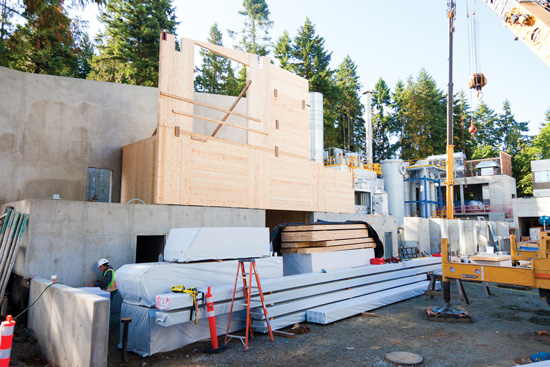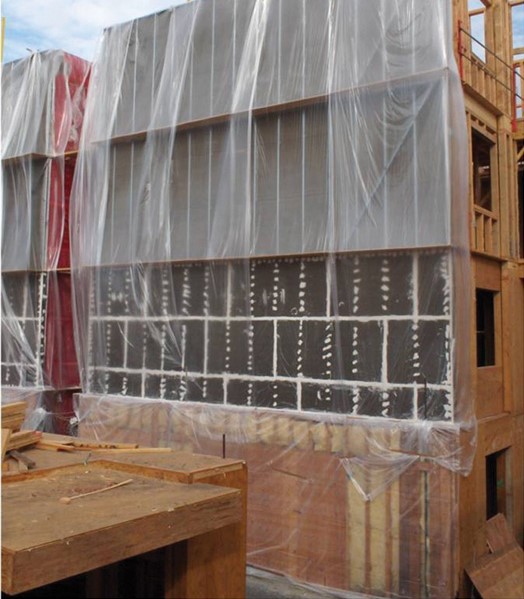Designing for Durability

Photo courtesy of KK Law
Once delivered to the construction site, wood should be stored and wrapped properly.
Construction: Keeping Wood Durable
Informed design is essential to durability, but encouraging proper material handling during construction will greatly improve the long-term performance of wood material in the building envelope. “While an architect’s role typically does not extend beyond specification of wood to materials handling and construction practices, specifications can state S-DRY or KD lumber as well as 19 percent maximum moisture content at time of enclosure,” says Paul Morris, research leader, durability and building enclosure at FPInnovations. “It would also be ideal if architects provided recommendations on how wood should be treated during construction. Even something as elementary as requiring field treatment of saw cuts in treated wood to seal newly exposed untreated wood would help protect the structure’s long-term durability.”
Weather Protection
Advanced planning to protect wood during construction can contribute to long-term durability. Material delivery should be timed as close to the installation date as possible. Too often, wood construction products, even for interior use, arrive at the construction site and are left outside and exposed to the elements, absorbing moisture from rain, snow, puddles, or soil. If wood does need to be stored for any length of time, a clean, well-drained material storage area is critical. Upon arrival, wood should be inspected to see that wrappers are intact—faulty ones should be replaced with heavy tarp—and then stored 6-8 inches off the ground away from ponding water. If the soil is wet or poorly drained, a polyethylene tarp or a temporary gravel pad should be placed on the ground below as supports for the materials. The storage area should also be free of vegetation which can harbor insects, hamper ventilation, and maintain moisture in the air.

Photo courtesy of Togawa Smith Martin, Inc.
This photo shows how a multi-story wood building can be protected from the elements.
After installation, the structure should be protected from rain and other sources of bulk water by installing roof coverings and moisture barriers on the exterior of the building envelope as soon as practicable. If elevated moisture levels exist, materials inside the building envelope should be adequately dried before installing insulation and other materials. It is best to avoid the premature application of interior membranes like gypsum wallboard. Allowing the wood framing to acclimate and lower its moisture content to the extent reasonable is highly desirable.
If lumber has been significantly wetted during construction, schedules should allow for drying of framing and sheathing materials to an MC of 19 percent or below. Moisture barriers, installed soon after assemblies are framed, will reduce exposure to weather. If needed, artificial heat and/or dehumidification can accelerate drying.









